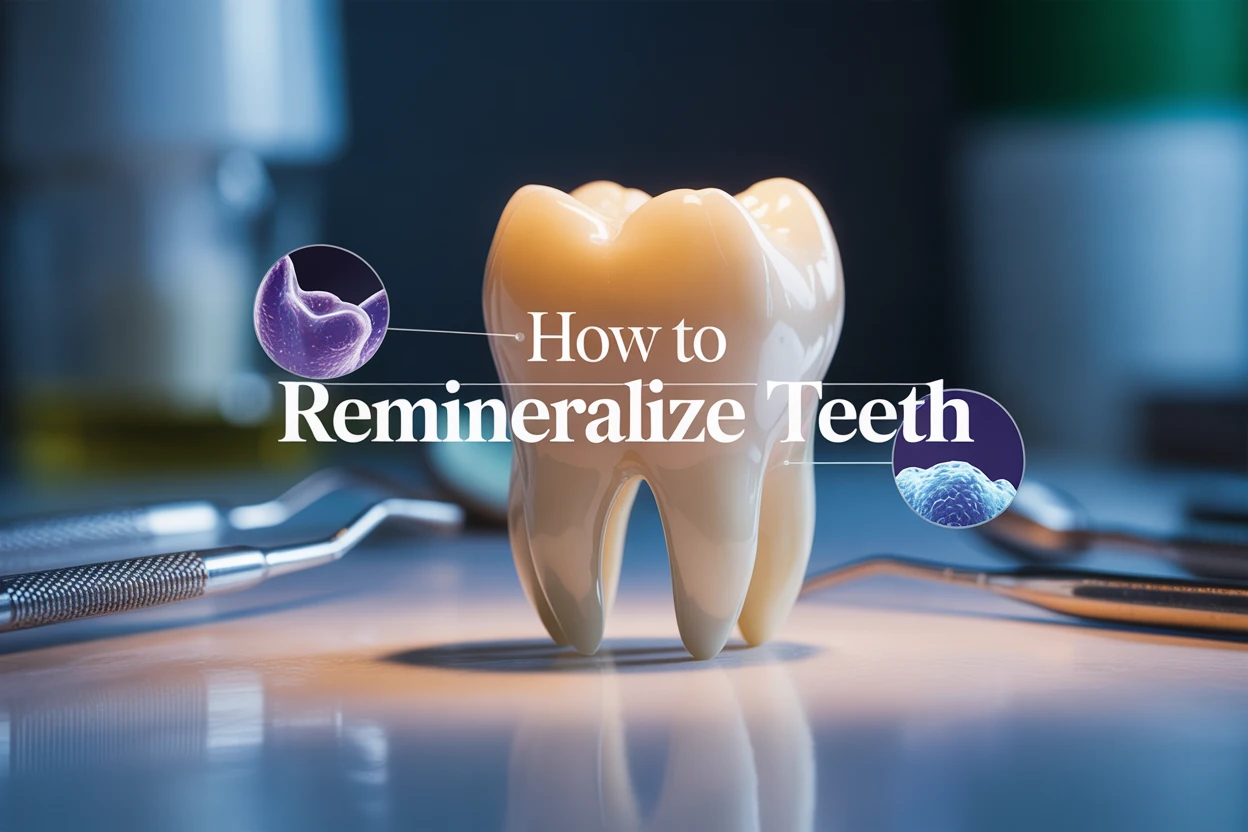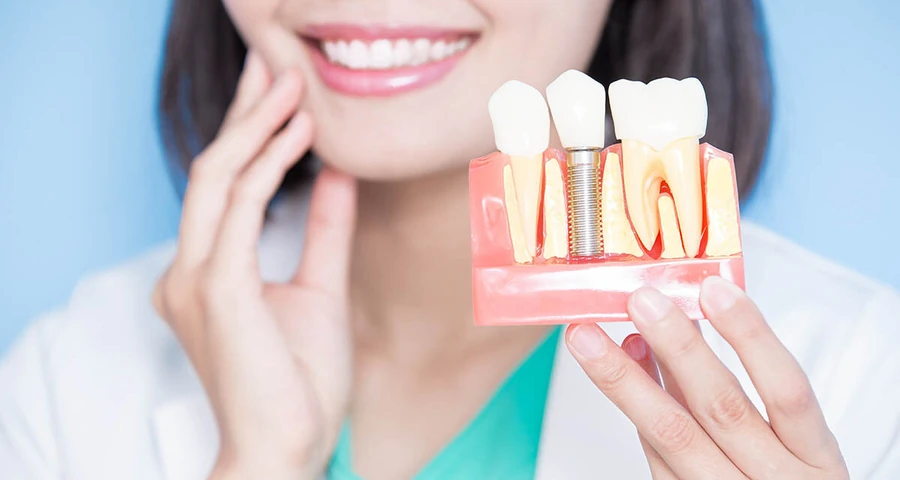It’s funny you don’t think about tooth enamel until something goes wrong. A sudden zing of tooth sensitivity when you sip an iced coffee. That dull ache after a little too much citrus. Maybe even the creeping thought, “Uh-oh… is this the start of tooth decay?”
How to remineralize teeth sounds a bit like magic at first, as if you can grow back what’s been lost. The truth is… You can’t exactly regrow enamel once it’s gone, but you can help it heal in a sense. Through remineralization, the remaining enamel can become stronger, more resistant, and less likely to break down further.
Enamel is your teeth’s armor. It’s the hardest substance in your body — harder than bone — but it’s also a bit like a windshield: once it’s chipped, you notice every little flaw. The good news? Science says there are ways to reverse early-stage damage and slow down or even stop growing enamel loss.
Before you book another dentist appointment out of panic (I’ve done that), it might be worth trying a few proven, at-home strategies. They won’t replace regular check-ups, but they could help you avoid bigger dental work later.
1. Understanding Tooth Enamel and Demineralization
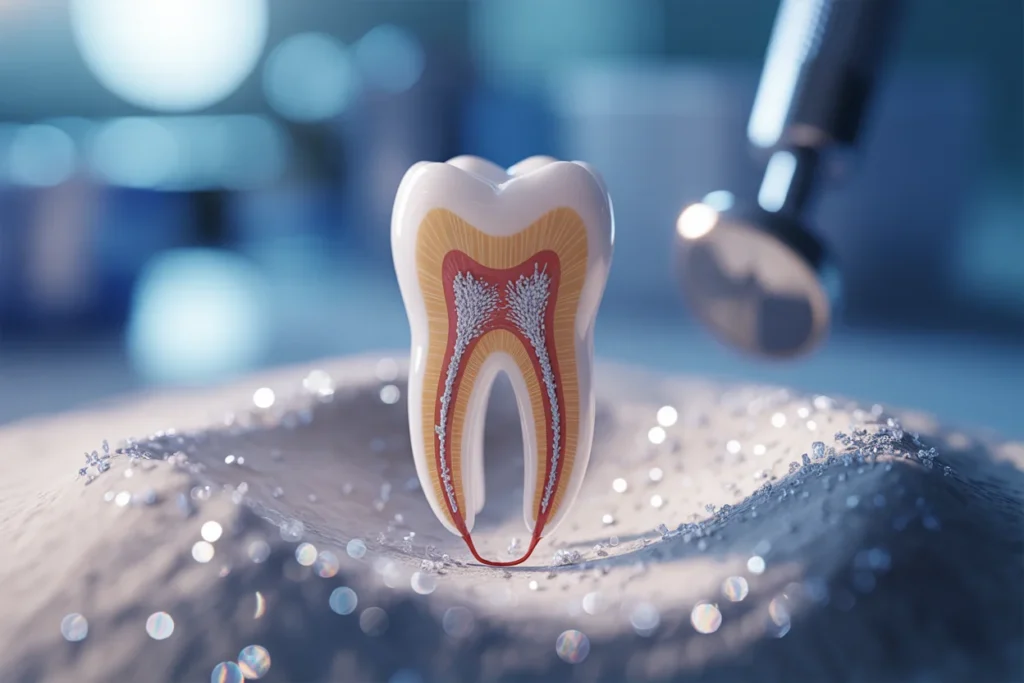
Enamel is basically a fortress wall made almost entirely of minerals, mostly hydroxyapatite crystals, a form of calcium phosphate. It’s thin (only a few millimeters at most) but incredibly dense, covering each tooth like a clear, protective shell.
It’s not living tissue, so it can’t “repair” itself in the way skin or bone can. But — and here’s the part that matters for teeth remineralization — it can reabsorb minerals from your saliva and certain foods or treatments, rebuilding some of its lost strength over time.
Pro Tip: The American Dental Association notes that even though enamel can’t regrow, supporting remineralization can significantly reduce the risk of cavities.
How Demineralization Happens?
The enemy here is acid, often from sugars and carbohydrates breaking down in your mouth. Streptococcus mutans (a mouth bacteria you probably didn’t know by name) turns sugar into acid. That acid seeps into enamel, dissolving the minerals bit by bit.
Other culprits?
- Acidic foods and drinks (citrus, sports drinks, fruit juices, even some teas)
- Frequent snacking (especially sticky carbs and dried fruits)
- Low saliva production — sometimes from dehydration, certain medications, or health conditions
- Poor oral hygiene habits that let dental plaque build up
Once enough minerals are lost, the enamel surface softens. Leave it long enough and you’re looking at cavities, gum disease, or worse.
Common Causes of Demineralization & Their Effects
| Cause | Example | Effect on Enamel |
| Sugary foods | Candy, pastries | Feeds bacteria → acid production |
| Acidic drinks | Soda, sports drinks | Lowers pH → enamel erosion |
| Dry mouth | Medications, aging | Reduces saliva → fewer minerals to rebuild |
| Poor oral care | Skipping flossing, brushing too hard | Plaque buildup, micro-abrasions |
2. Recognizing the Signs of Weak or Demineralized Enamel
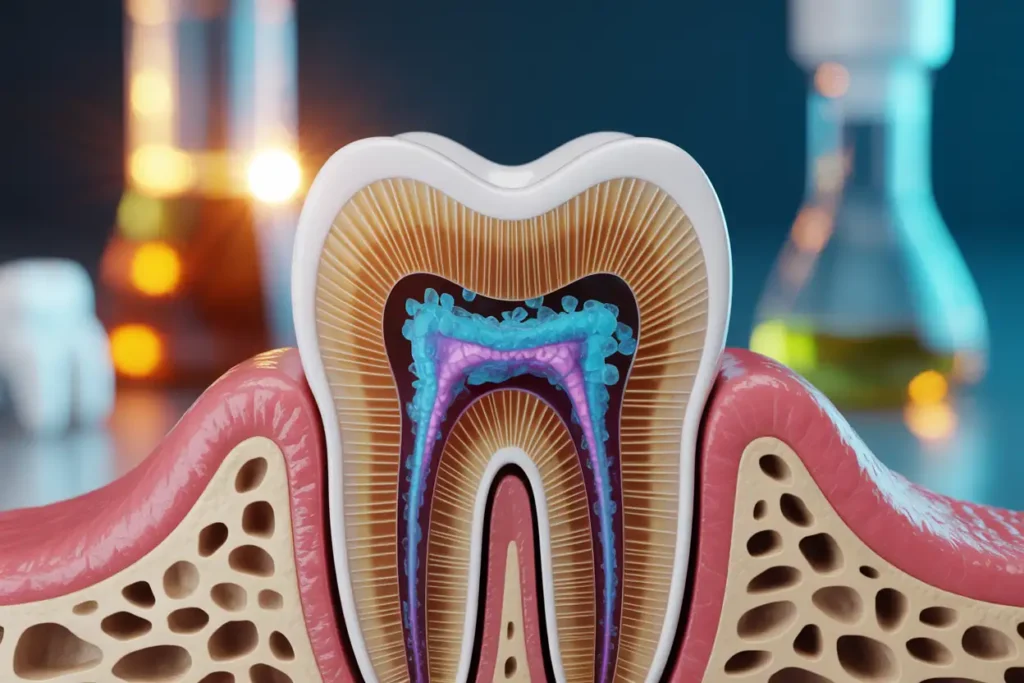
Sometimes you just know something’s off with your teeth. Not in a “call 911” way, but in a “hmm, that didn’t feel right” kind of way. Weak enamel often whispers before it screams. You might notice:
- A twinge of tooth sensitivity when drinking something hot or cold.
- A change in the way light hits your teeth — maybe they look a little more transparent at the edges.
- Small rough spots you can feel with your tongue.
- Patches of discoloration that brushing doesn’t fix.
These can be early tooth decay signs — and yes, they’re often tied to demineralization. If you catch them early, you can remineralize teeth naturally before the problem escalates into a cavity or periodontitis disease issue.
One thing I learned (the hard way) is that early enamel erosion and cavities aren’t the same. Cavities are like a pothole; early erosion is more like soft asphalt — still repairable if you act quickly.
Pro Tip: If your teeth feel different after eating acidic fruits or sipping sports drinks, rinse your mouth with plain water right after. It helps neutralize pH before enamel takes the hit.
Weak Enamel Symptoms vs. Cavity Symptoms
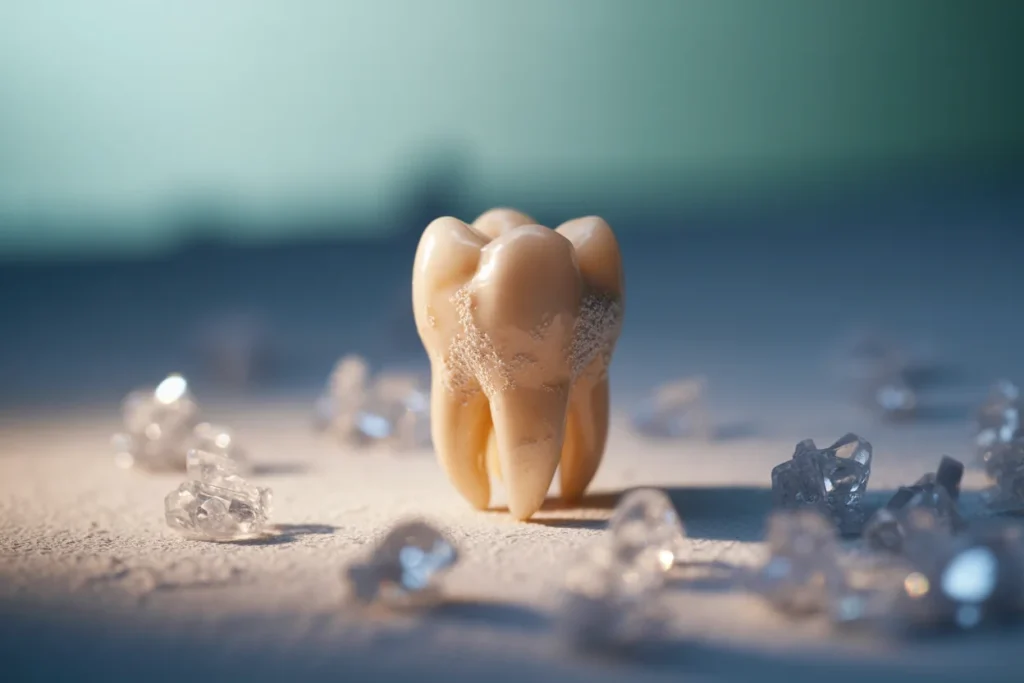
| Symptom | Weak Enamel | Cavity |
| Sensitivity | Often mild, triggered by temperature changes | Persistent, sharper pain |
| Discoloration | White or slightly yellow patches | Dark brown or black spots |
| Surface feel | Smooth but thinner | Rough or pitted |
| Reversibility | Possible with remineralization | Requires dental fillings |
3. Tip #1 – Boost Mineral Intake Through Diet
If there’s one thing dental professionals and nutritionists agree on, it’s that enamel health starts in the kitchen. Minerals are your enamel’s building blocks, and without enough, your body can’t maintain that protective barrier.
Here’s where it gets interesting: the process of teeth remineralization isn’t just about brushing more or using the right toothpaste — it’s also about giving your salivary glands the raw materials they need to repair micro-damage.
Eat Enamel-Friendly Foods
- Dairy products like cheese and yogurt — rich in calcium and casein, which protect against acid erosion.
- Leafy greens (spinach, kale) — loaded with calcium and magnesium for tooth enamel repair.
- Almonds — low in sugar, high in minerals.
Include Phosphorus & Magnesium Sources
- Nuts & seeds (pumpkin, sunflower) — important for bone and enamel regeneration.
- Fish (salmon, sardines) — phosphorus-rich for mineral balance.
Vitamin D for Calcium Absorption
- Sunlight exposure — just 10–15 minutes a day can boost Vitamin D levels.
- Fatty fish, like mackerel or tuna.
- Supplements — Vitamin D3 often works best, especially paired with Vitamin K2 to prevent calcium chelation (when calcium deposits in the wrong places).
Pro Tip: If you follow a vegan diet, you can still support remineralization. Focus on fortified plant milks, tofu set with calcium sulfate, and fiber-rich fruits and vegetables that promote saliva production — your natural defense against mouth bacteria like Streptococcus mutans.
4. Tip #2 – Use Remineralizing Toothpaste and Mouth Rinses
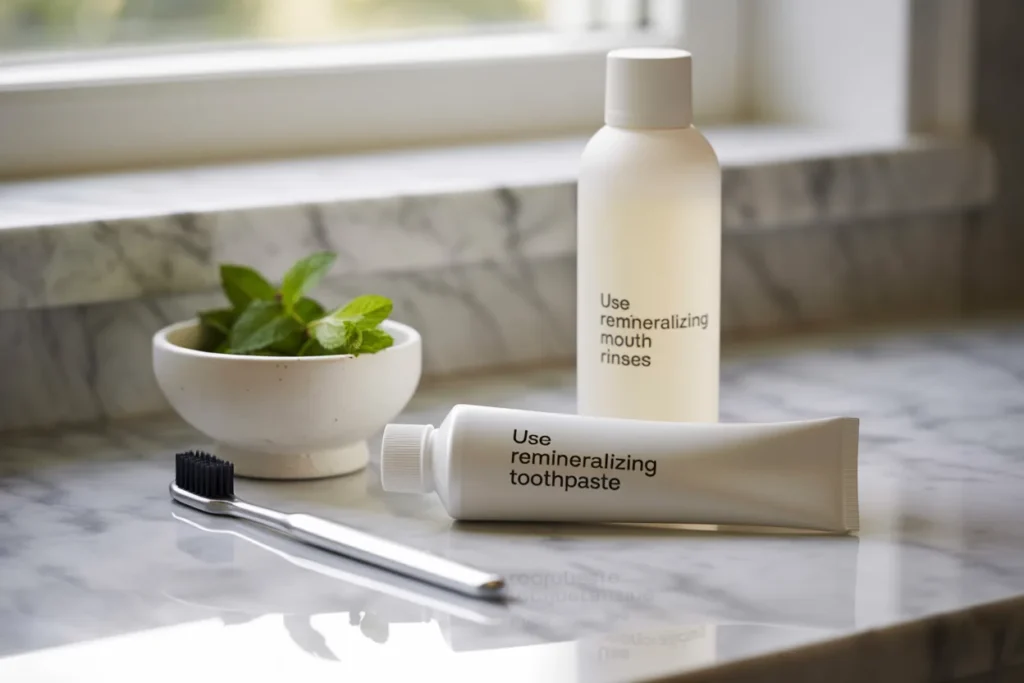
I used to think toothpaste was just toothpaste — minty, foamy, done. But when you’re trying to remineralize teeth or protect weakened tooth enamel, what’s in that tube (or bottle) actually matters a lot.
Key Ingredients to Look For
- Fluoride toothpaste — still the gold standard, endorsed by the American Dental Association for preventing tooth decay and supporting enamel repair.
- Hydroxyapatite — a mineral almost identical to the crystals in enamel; some holistic oral care fans prefer it as a fluoride alternative.
- Xylitol — not just a sweetener; it helps inhibit mouth bacteria like Streptococcus mutans.
You’ll also see options like Intensive Enamel Repair Mouthwash or products with probiotic bacteria to balance the oral microbiome. The idea isn’t to throw everything at your teeth, but to choose what fits your needs and stick with it.
How to Use Them Effectively?
- Brush twice a day — but don’t rush. Two full minutes let the active ingredients work.
- Spit, don’t rinse — at least not right away. Leaving a thin layer of fluoride or hydroxyapatite helps enamel reabsorb minerals.
- Mouth rinses — choose alcohol-free varieties if you struggle with dry mouth; some alcohol-based rinses can lower saliva production.
Pro Tip: Pair a remineralizing toothpaste with a gentle flossing routine and fluoridated water. The combo helps minerals reach spots between teeth where enamel loss often starts.
Common Remineralizing Ingredients and Their Benefits
| Ingredient | Main Benefit | Bonus Effect |
| Fluoride | Strengthens enamel, prevents cavities | Reduces sensitivity |
| Hydroxyapatite | Repairs micro-damage | Whitens naturally |
| Xylitol | Inhibits harmful bacteria | Freshens breath |
5. Tip #3 – Reduce Acidic and Sugary Foods
Here’s the tricky part — a lot of the things that wear down your enamel are also, well, delicious. Acidic fruits, Drink sodas, a post-workout sports drink… they’re part of everyday life. But if you’re serious about tooth enamel repair and preventing acid erosion, you’ll need to make a few swaps.
Understanding pH and Oral Health
Your mouth normally sits at a pH of about 7 (neutral). Drop that number below 5.5 and you’re in the “demineralization zone,” where enamel starts dissolving. That’s why acidic foods and drinks are a big deal in dental health — they create conditions where minerals leach out faster than they can go back in.
Practical Swaps and Tips
- After acidic drinks (like fruit juices, wine, or sports drinks), drink water or chew sugar-free gum to stimulate saliva flow.
- Swap sticky sweets and dried fruits for fiber-rich fruits and vegetables like apples or celery.
- If you love citrus, eat it with a meal to buffer acidity.
- Limit Himalayan sea salt gargles — while they can be soothing, overuse may disrupt your mouth’s pH.
Pro Tip: Timing matters. Brushing right after eating acidic foods can actually scrub softened enamel away. Wait at least 30 minutes before brushing.
6. Tip #4 – Stay Hydrated and Maintain Saliva Flow

If there’s a secret hero in dental health, it’s saliva. Not glamorous, I know — but without enough of it, the whole process of teeth remineralization slows down. Saliva’s job? Neutralize acids, wash away food particles, and deliver minerals like calcium and phosphate straight to your tooth enamel.
When your salivary glands aren’t keeping up — maybe because of certain medications, aging, dehydration, or even stress — you’re left with dry mouth, and that opens the door to gum disease, tooth sensitivity, and faster acid erosion.
Natural Ways to Stimulate Saliva
- Chew sugar-free gum — xylitol gum is especially good for fighting mouth bacteria like Streptococcus mutans.
- Eat crunchy veggies — carrots, celery, and apples boost chewing and saliva flow.
- Sip water often — especially fluoridated water, which doubles up on oral care benefits.
- Try oil pulling with coconut or sesame oil — some people find it helps reduce bacteria that contribute to tooth decay.
Pro Tip: Avoid overusing strong mouth rinses with hydrogen peroxide or alcohol if you already have a dry mouth; they can reduce moisture even further.
Saliva Boosters vs. Saliva Inhibitors
| Boosts Saliva | Inhibits Saliva |
| Sugar-free gum | Alcohol-based mouthwashes |
| Crunchy fruits & veggies | Caffeine-heavy drinks |
| Staying hydrated | Certain blood pressure meds |
| Mild herbal teas | Tobacco products |
7. Tip #5 – Practice Gentle but Consistent Oral Hygiene
This is where a lot of people — myself included — make mistakes. We think that scrubbing harder means cleaner teeth, but brushing too hard actually damages tooth enamel and can cause gum recession. If you want to remineralize teeth and keep them strong, the trick is to be gentle but consistent.
Why Brushing Too Hard Damages Enamel?
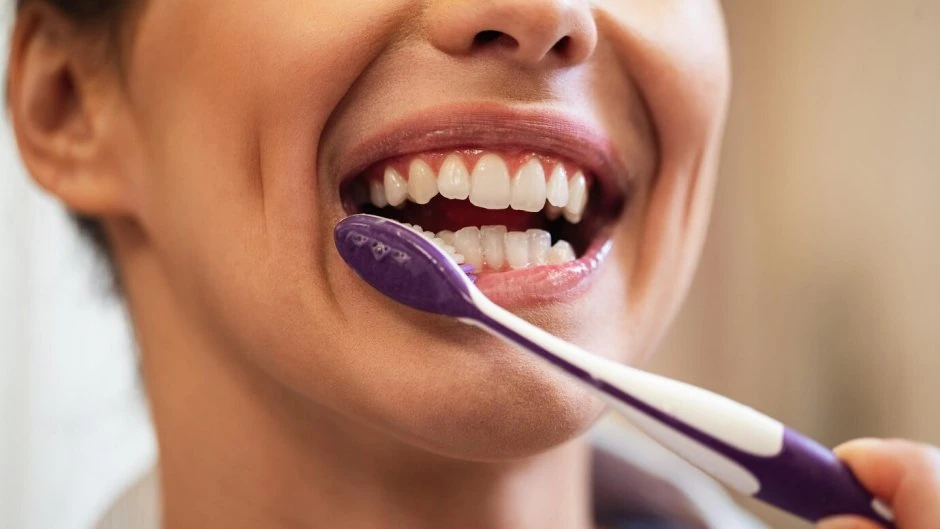
Enamel may be the hardest substance in your body, but it’s still vulnerable to mechanical wear. Combine aggressive brushing with acidic foods in your diet, and you’re basically sanding your teeth down over time. Dental hygienists see this a lot — those telltale grooves near the gumline.
Best Brushing & Flossing Techniques
- Use a soft-bristled brush — manual or electric, as long as it’s gentle.
- Small, circular motions, rather than long scrubbing strokes.
- Floss daily — not just for gum health, but because trapped food can feed the bacteria behind cavities and dental plaque.
- Replace your toothbrush every 3 months — frayed bristles are enamel’s enemy.
Pro Tip: If you grind your teeth at night, consider a custom night guard. Dental professionals often recommend them to protect against tooth sensitivity and micro-fractures that weaken enamel over time.
8. Bonus Tips for Extra Enamel Protection
Once you’ve got the basics down — diet, hydration, gentle oral hygiene — you can add a few extra layers of protection for your tooth enamel. Think of these as bonus armor in your holistic approach to dental health.
1. Oil Pulling
This is one of those ancient practices that’s oddly meditative. Swish a tablespoon of coconut or sesame oil around your mouth for 10–15 minutes (yes, minutes). It’s thought to help reduce mouth bacteria and freshen breath, potentially supporting teeth remineralization over time.
2. Remineralizing Gels & Pastes
Some dental professionals recommend calcium- and phosphate-based gels you apply after brushing. They’re like a concentrated mineral bath for your enamel.
3. Night Guards for Teeth Grinders
If you’ve ever woken up with a sore jaw, you might be grinding in your sleep. That micro-friction can wear down enamel even faster than acid erosion. A custom night guard from a dentist appointment can prevent that.
Pro Tip: If you’ve had dental work like fillings, crowns, or dental sealants, protecting surrounding enamel is even more important — weakened edges are more prone to decay.
Bonus Enamel Protection Options
| Method | Best For | Extra Notes |
| Oil pulling | Reducing bacteria | Avoid swallowing oil |
| Remineralizing gels | Targeted enamel support | Often used at night |
| Night guard | Teeth grinders | Custom-fit works best |
9. Myths About Enamel Repair You Should Stop Believing
There’s a lot of “miracle” advice floating around on how to remineralize teeth, and while some tips have merit, others… not so much.
“You Can Regrow Enamel Overnight”
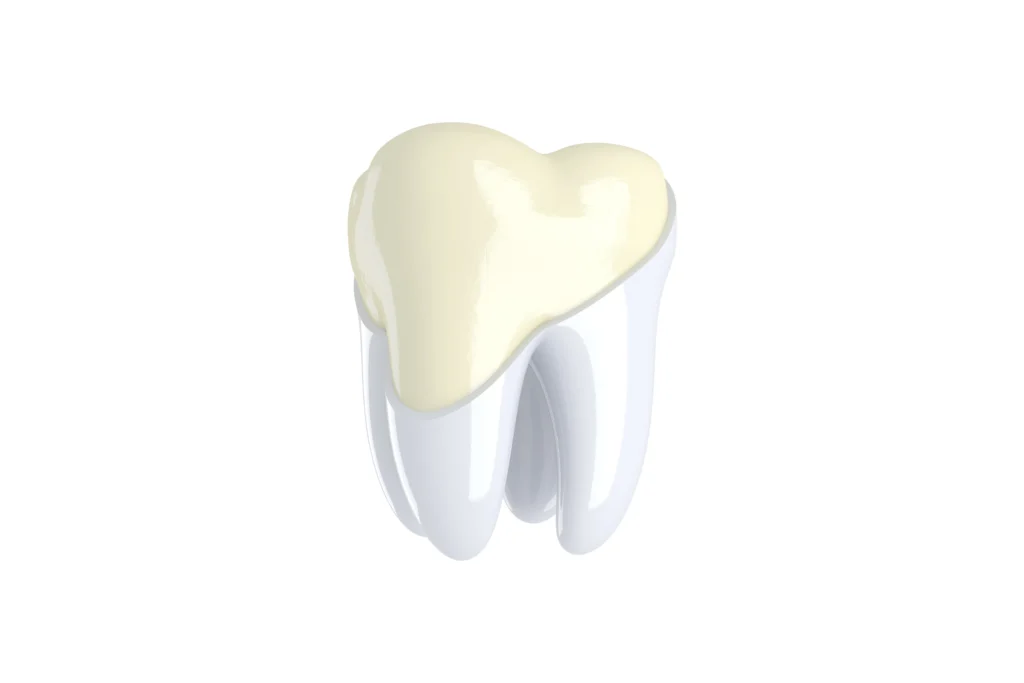
Nope. Enamel regeneration is a slow process. Even with perfect oral care and fluoride toothpaste, rebuilding mineral density takes weeks to months. Anyone promising an overnight fix is probably skipping the science.
“Natural Remedies Replace Brushing”
I love herbal rinses and Himalayan sea salt gargles as much as anyone, but skipping your toothbrush in favor of them? Big mistake. Plaque doesn’t dissolve in coconut oil alone — you still need mechanical cleaning to prevent gum disease and mouth cavities.
Pro Tip: Check claims with trusted sources like the American Dental Association or peer-reviewed dental research. Not all “natural” is automatically safe, especially if it delays necessary treatment.
10. When to See a Dentist?
Even if you’ve mastered every at-home strategy for how to remineralize teeth, there are moments when only a dental professional can step in and prevent things from getting worse. Think of it as a partnership — your daily oral care habits plus their advanced tools.
Early Intervention Signs
- Persistent tooth sensitivity even after dietary changes.
- Visible cracks or chips in tooth enamel.
- Gum recession is exposing sensitive root surfaces.
- White or brown spots that don’t improve with remineralization methods.
Professional Remineralization Treatments
- Fluoride varnishes — a stronger dose than what’s in fluoride toothpaste.
- Dental sealants — especially for molars, sealing deep grooves that trap bacteria.
- Intensive Enamel Repair Mouthwash — often prescription-strength.
- Calcium phosphate applications — targeted mineral boosts for weakened areas.
Pro Tip: A regular dental check-up (every 6 months) is still one of the best defenses against tooth decay and gum disease — even if you follow every tip in this guide.
Conclusion
The path to stronger enamel isn’t instant, but it’s absolutely possible. By combining a holistic approach — diet, hydration, gentle brushing, smart product choices, and maybe a few bonus tricks like oil pulling — you can slow, stop, and in some cases reverse early-stage acid erosion.
Every sip of water, every crunchy vegetable, every mindful brushing session… they all add up. And the best part? You don’t have to overhaul your life in a week. Small, consistent changes really can give your teeth the second chance they deserve.
When you understand how to remineralize teeth, you start to see that it’s less about quick fixes and more about steady, protective habits. Even small swaps, like replacing a soda with fluoridated water or choosing a calcium-rich snack, matter over time. Think of it as giving your enamel the daily care it’s quietly been asking for.
So, start today. Your enamel — and your future self — will thank you with every confident bite.
Frequently Asked Questions
1. Can you really repair enamel naturally?
Kind of. You can’t grow it back like new, but you can remineralize teeth and make them more resistant to decay. With the right habits, you can slow down damage and help your tooth enamel stay stronger for years.
2. How long does remineralization take?
Weeks to months, depending on diet, oral care, and your starting point. Patience matters here — you won’t see changes overnight, but consistency pays off.
3. Does fluoride really work?
Yep. It’s backed by decades of dental research and the American Dental Association. It works by making enamel more resistant to acid attacks from bacteria and sugary foods.
4. Is hydroxyapatite as good as fluoride?
It’s promising, especially for people avoiding fluoride, but research is still catching up. Some studies suggest it can fill in tiny enamel defects and reduce tooth sensitivity.
5. Can dry mouth cause enamel loss?
Absolutely. Low saliva production means fewer minerals and less acid neutralization. Over time, this can speed up acid erosion and increase your risk of cavities.
6. Do sports drinks damage enamel?
Yes — their acidity and sugar feed bacteria and weaken tooth enamel. Even sugar-free versions can lower your mouth’s pH enough to trigger demineralization.
7. What foods help remineralize teeth?
Dairy, leafy greens, nuts, seeds, and fiber-rich fruits and vegetables are all winners. They provide the calcium, phosphorus, and vitamins your enamel needs to stay strong.
8. Is oil pulling worth it?
It can help with bacteria balance, but it’s not a replacement for brushing or flossing. Think of it as an optional extra step, not your main line of defense against tooth decay.
9. Do dental sealants help adults?
Yes — they’re not just for kids. Sealants can protect vulnerable chewing surfaces from acid erosion and help prevent plaque buildup in hard-to-clean grooves.
10. When should I see a dentist?
If sensitivity persists, spots appear, or enamel looks more transparent despite your efforts, book that dentist appointment. Early dental check-ups often mean simpler, less invasive treatments.

